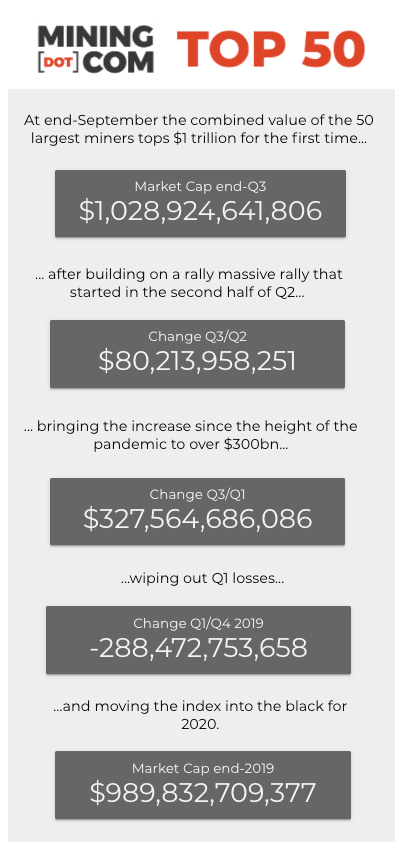
Mining’s majors looked poised to join the trillion dollar club at the outset of 2020, but the pandemic torpedoed the early stages of a cyclical upswing for the industry, delaying the milestone by nine months.
Measured from the height of the pandemic in March-April, the index has recovered by nearly $330 billion.
Shiny happy goldminers
Primary gold producers and precious metals royalty companies now make up more than a third of the value of the top 50 and contributed $130 billion of the gains since the Q1 slump.
Nine out of ten of the best performers over the quarter are gold producers. No. 2 on the winners’ list is copper giant Freeport McMoRan, which, thanks to its Grasberg mine also ranks as one of the world’s largest gold producers.
New this year are Evolution Mining, B2Gold and Yamana; Newmont and Barrick now look entrenched in the top five while Moscow’s Polyus becomes the third precious metals miner to make it into the top 10 after also getting a lift from its status as a rouble hedge.
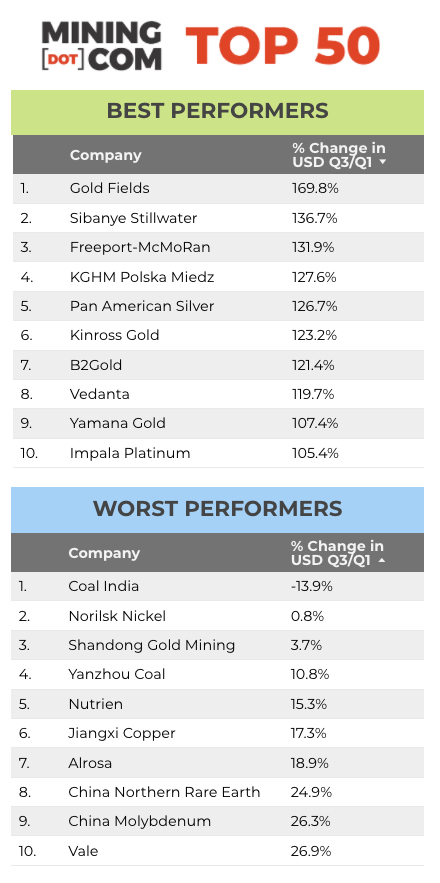
St. Petersburg-based gold miner Polymetal has jumped 10 positions in the ranking this year and despite losing delisted potash giant Uralkali, Russian firms’ combined value climbed on a relative basis during the quarter, now constituting nearly 12% of the ranking despite an underperforming Norilsk.
Diverse outcomes
Glencore’s bad run continues with the integrated Swiss trader and miner falling out of the top 10 after a $14.5 billion year-to-date market value drop compounded by a depreciating pound sterling.
Anglo American added $4.4 billion during the quarter but remains down nearly 30% from its opening levels for the year while India’s Vedanta makes a comeback after dropping to as low as number 49 at the end of Q1.
Diversified companies make up 41% of the index.
Copper comeback
Copper’s comeback helped Poland’s KGHM return to the ranking after a 128% rise since the end of the Q1 while Ivanhoe Mines – advancing a giant copper mine in the Congo – could become the sole non-producing company to enter the top 50.
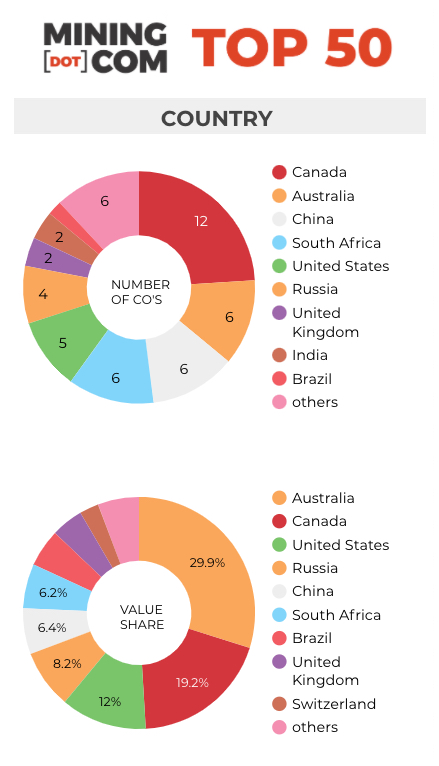
The Vancouver-based company is currently hovering at 53 with a value approaching $4.4 billion on September 30. Ivanhoe would have to edge out Saudi copper-gold company Ma’aden, which only three years ago was in the top 20 and fertilizer producer Israel Chemicals currently at number 51.
Low energy
The world’s largest uranium producers – Cameco and Kazatomprom – once again fail to make the top 50 despite a rally in the nuclear fuel to around the $30 a pound level.
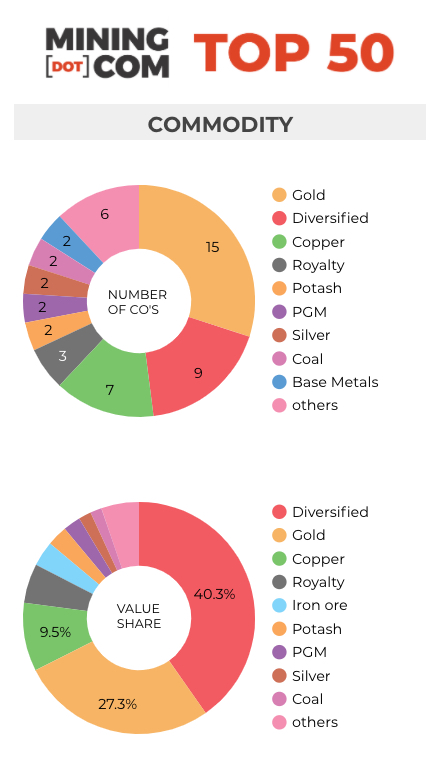
The two remaining coal companies (the ranking excludes power utilities such as Shenhua Energy that operate their own mines) performed poorly, with Coal India at number 28 – the only company to lose value in USD terms since end-Q1. Four years ago the world’s largest coal miner made it to no. 4.
Yanzhou Coal slipped 10 places this year to number 46 and if the sector woes continue and precious metals momentum continues – it may well leave the top 50 with a single coal company.
Tianqi tanks, Joeys jumps
The last remaining primary lithium producer, Tianqi, falls out of the top 50 versus as high as no. 32 three years ago, but Chile’s SQM is having a great year, climbing eight spots after more than doubling from its covid lows.
Another former Chinese battery metals highflyer – China Molybdenum – is down another two spots in the quarter to number 35 after briefly cracking the top 10 at the end of 2017 when cobalt prices were rallying.
With Tianqi and Hong Kong listed gold producer Zhaojin leaving the top 50, the number of Chinese companies drops to six with a combined market value of $65.7 billion, just ahead of South African firms with primary listings in Johannesburg.
Click on image for full size table of the MINING.COM TOP 50:
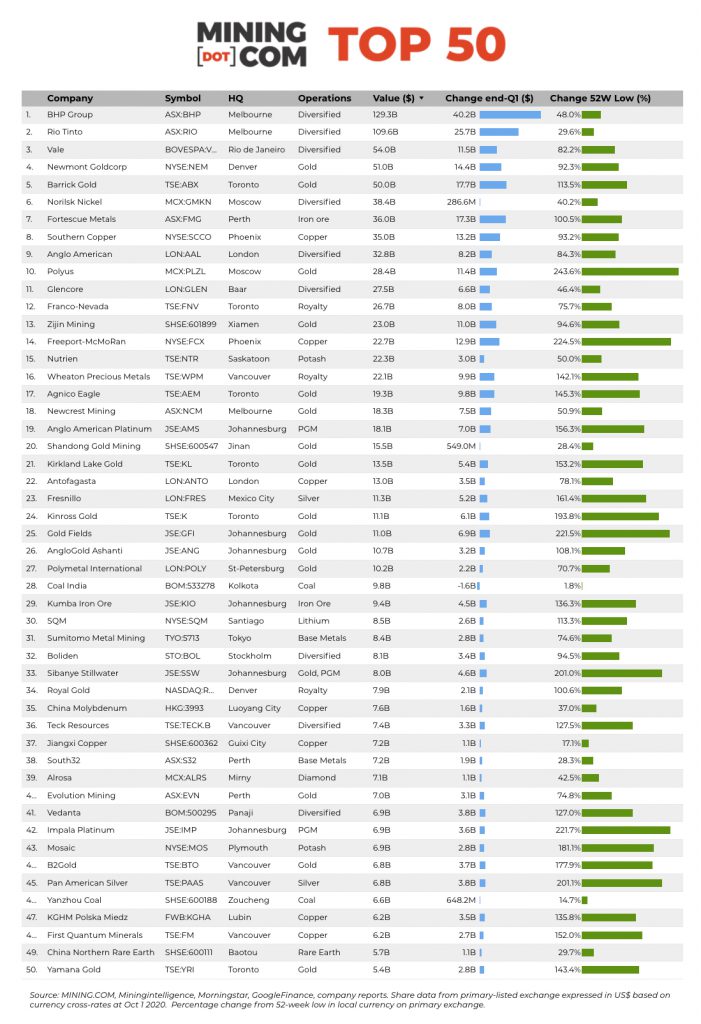
Notes:
Source: MINING.COM, MiningIntelligence, Morningstar, GoogleFinance, company reports. Share data from primary-listed exchange expressed in US$ based on currency cross-rates at Oct 1 2020. Percentage change from 52-week low in local currency on primary exchange.
As with any ranking, criteria for inclusion are contentious. We decided to exclude unlisted and state-owned enterprises at the outset due to a lack of information. That, of course, excludes giants like Chile’s Codelco, Uzbekistan’s Navoi Mining, which owns the world’s largest gold mine, Eurochem, a major potash firm, trader Trafigura, top uranium producer Kazatomprom (which is partially listed on the LSE) and numerous entities in China and developing countries around the world.
Another central criterion was the depth of involvement in the industry before an enterprise can rightfully be called a mining company.
For instance, should smelter companies or commodity traders that own minority stakes in mining assets be included, especially if these investments have no operational component or not even warrant a seat on the board?
This is a common structure in Asia and excluding these types of companies removed well-known names like Japan’s Marubeni and Mitsui, Korea Zinc and Chile’s Copec.
Levels of operational involvement and size of shareholding were central considerations.
Do streaming and royalty companies that receive metals from mining operations without shareholding qualify, or are they just specialized financing vehicles? We included Franco Nevada, Royal Gold and Wheaton Precious Metals.
What about diversified companies such as BHP or Teck with substantial oil and gas assets? Or oil sands companies that use conventional mining methods to extract bitumen for that matter?
Vertically integrated concerns like Alcoa and energy companies such as Shenhua Energy where power, ports and railways make up a large portion of revenues pose a problem as does diversified companies such as Anglo American with separately listed majority-owned subsidiaries. We’ve included Angloplat in the ranking as well as Kumba Iron Ore.
Chemical companies are also problematic – should Albemarle not be ranked because its potash and lithium operations are such a small part of its overall revenues? The same issue applied to FMC before it spun off its lithium business.
Many steelmakers own and often operate iron ore and other metal mines, but in the interest of balance and diversity we excluded the steel industry, and with that many companies that have substantial mining assets including giants like ArcelorMittal, Magnitogorsk, Ternium, Baosteel and others.
Head office refers to operational headquarters wherever applicable, for example BHP and Rio Tinto are shown as Melbourne, Australia but Antofagasta is the exception that proves the rule. We consider the company’s HQ to be in London, where it has been listed since the late 1800s.
Trading data from primary listing exchange and currency cross-rates at the date of publication. Market capitalization calculated at primary exchange, where applicable from total shares outstanding, not only free-floating shares.
Please let us know of any omissions, deletions or additions to the ranking or suggest a different methodology.




